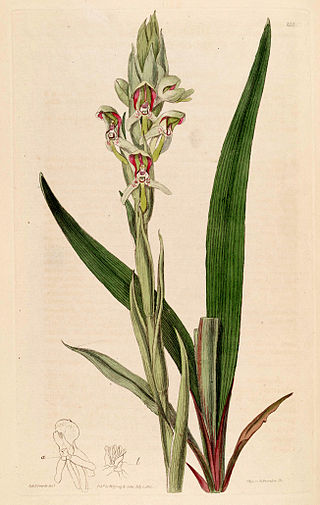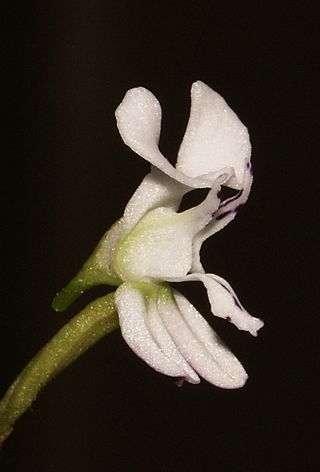
Orchids are plants that belong to the family Orchidaceae, a diverse and widespread group of flowering plants with blooms that are often colourful and fragrant. Orchids are cosmopolitan plants that are found in almost every habitat on Earth except glaciers. The world's richest diversity of orchid genera and species is found in the tropics.

Freesia is a genus of herbaceous perennial flowering plants in the family Iridaceae, first described as a genus in 1866 by Christian Friedrich Ecklon (1886) and named after the German botanist and medical practitioner, Friedrich Freese (1795-1876). It is native to the eastern side of southern Africa, from Kenya south to South Africa, most species being found in Cape Provinces. Species of the former genus Anomatheca are now included in Freesia. The plants commonly known as "freesias", with fragrant funnel-shaped flowers, are cultivated hybrids of a number of Freesia species. Some other species are also grown as ornamental plants.

The Aizoaceae, or fig-marigold family, is a large family of dicotyledonous flowering plants containing 135 genera and about 1800 species. They are commonly known as ice plants or carpet weeds. They are often called vygies in South Africa and New Zealand. Highly succulent species that resemble stones are sometimes called mesembs.

Disa is a genus of flowering plants in the family Orchidaceae. It comprises about 182 species. Most of the species are indigenous to tropical and southern Africa, with a few more in the Arabian Peninsula, Madagascar, and Réunion. Disa bracteata is naturalised in Western Australia, where the local name is "African weed-orchid."

Carpobrotus, commonly known as pigface, ice plant, sour fig, Hottentot fig, and clawberry is a genus of ground-creeping plants with succulent leaves and large daisy-like flowers. The name comes from the Ancient Greek karpos "fruit" and brotos "edible", referring to its edible fruits.

Caralluma is a genus of flowering plants in the family Apocynaceae, consisting of about 120 species.

Disa stairsii is a species of Disa of the family Orchidaceae that can be found growing with the giant heathers on the Rwenzori Mountains of mountains in East Tropical Africa as well as in the Congo in West-Central Tropical Africa.

Disa cardinalis is a species of orchid found in South Africa.

Disa cernua is a species of orchid found in South Africa, in Eastern Cape and Western Cape provinces.

Disa cornuta is a species of orchid found from Zimbabwe to South Africa.

Disa draconis is a species of orchid found in South Africa.

Disa sagittalis is a species of orchid found in South Africa from south and southeast Cape Province to southern KwaZulu-Natal.

Disa tripetaloides is a species of orchid that grows along the edges of streams in South Africa. This is one of the smaller species in the genus Disa in the section Disa. There are populations that come from the winter-rainfall areas of South Africa, and summer-rainfall areas of South Africa.

Bauhinia galpinii is a species of shrub in the family Fabaceae. It is endemic to parts of eastern and southern Africa, where its popular name is "pride of De Kaap". In other places however, it is variously known as orchid tree, red bauhinia, nasturtium bauhinia, African Plume, red orchid bush, and by other informal names. The species name commemorates E. E. Galpin, a South African botanist and banker. Its common names include South African orchid bush, red bauhinia and Nasturtium bush.
Disa borbonica is a species of orchid in the Orchidaceae family. It is endemic to Réunion.

Disa graminifolia is a species of orchid found in the Cape Floristic Region of South Africa.

Chikanda is a Zambian dish made from the boiled root tubers of terrestrial orchids also called chikanda. The dish is often called "African polony" because it has a texture that resembles bologna. Chikanda can be eaten as a snack, dessert, or an accompaniment to nshima, a maize flour porridge.

Disa aurata is a species of orchid found in Swellendam area of Cape Province, South Africa at elevations of 0 – 1000 meters.

Disa virginalis is a species of orchid found in Southwest Cape Province, South Africa.
Disa intermedia is a species of orchid, native to Eswatini, formally Swaziland.
















